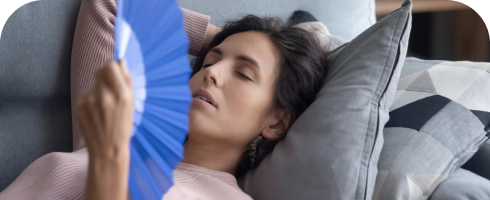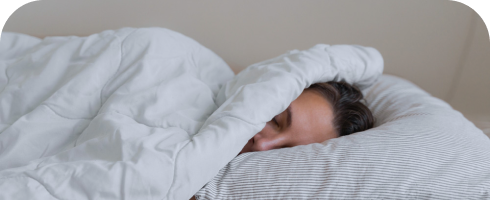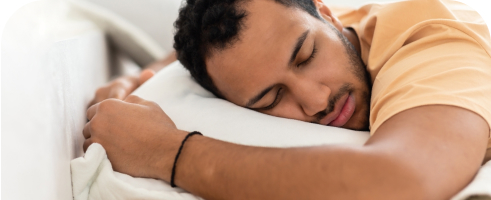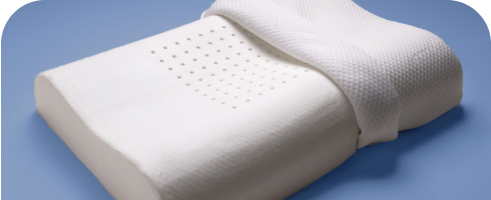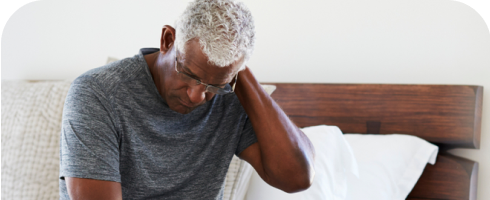Sleeping With a Pillow Between Your Knees
Sleeping with a pillow between your knees can improve spinal alignment, reduce pressure on your hips and knees, and ease back pain, especially if you sleep on your side. By helping to keep your body in a more neutral position, it can lead to a more comfortable and restful night’s sleep. Back sleepers can also benefit by placing a pillow under their knees to relieve lower back tension.
It may sound odd, but tucking a pillow between your knees could be the nighttime game-changer you didn’t know you needed. While side sleepers often place a pillow between their knees, back sleepers might find relief by placing one under them.
In both cases, the goal is the same: promoting better alignment through the spine, hips, and pelvis to ease pressure and reduce discomfort. This simple can be especially helpful for side sleepers and pregnant individuals.
You don’t necessarily need a fancy pillow to get started, but using one designed specifically for knee support can offer extra comfort and stability thanks to its shape and firmness. In this article, we’ll break down the benefits, who’s most likely to benefit, and how to choose the best knee pillow for you.
Benefits of Sleeping With a Pillow Between Your Knees
While it might seem like a small adjustment, placing a pillow between your knees can have a big impact on how you sleep—and how you feel in the morning. Let’s take a closer look at why this positioning works.
Proper Spinal Alignment
Sleeping with a pillow between your knees can help keep your spine in a more natural, neutral position, especially if you sleep on your side. Without support, your top leg may fall forward and twist your lower back, subtly pulling your spine out of alignment. A knee pillow helps keep your hips stacked and your spine aligned, reducing the strain that can build up overnight from poor sleeping posture and making a big difference in how supported you feel.
Reduce Hip and Back Pain
Placing a pillow between your legs can make a noticeable difference if you deal with hip or lower back discomfort. By keeping your legs aligned and preventing your hips from twisting during the night, a knee pillow helps reduce strain on your lower back and pelvis. This added support promotes better spinal symmetry, which may ease pressure on sensitive joints and muscles .
Knee pillows can be especially helpful for people dealing with sciatica, herniated discs, hip bursitis, or other conditions that cause lower back and pelvic pain.
Help Prevent Knee Pain
If your knees press against each other while you sleep, it can lead to discomfort, especially if you already deal with knee sensitivity or joint pain. This is a common issue for side sleepers, whose legs naturally stack one on top of the other during the night. Without anything between them, the pressure from one knee can dig into the other, causing soreness or even disrupting sleep.
A knee pillow creates a soft, supportive barrier that cushions the knees and helps distribute the weight of your legs more evenly.
Support Blood Circulation
Sleeping with a pillow between your knees can help improve blood flow, especially for when you’re sleeping on your side. By keeping your hips, legs, and spine better aligned, a knee pillow prevents blood vessels from becoming compressed, which can sometimes happen when legs are stacked unevenly or twisted during the night. This improved alignment encourages healthier circulation, which may help reduce numbness, tingling, or swelling in the legs and feet.
Ease Pregnancy Discomfort
As the body changes during pregnancy, pressure on the hips, lower back, and pelvis often increases, especially when sleeping on your side. A knee pillow can make a big difference by supporting the weight of the top leg, promoting better spinal alignment, and reducing strain on sensitive joints. Many pregnant sleepers find that using a knee pillow helps them feel more stable and less achy during the night.
Types of Sleepers Who Can Benefit From Knee Pillows
Side Sleepers
Because this sleeping position naturally creates space between the knees, adding a supportive cushion helps prevent the legs from collapsing inward and throwing off spinal alignment. If you consistently sleep on your side, using a knee pillow may feel more natural and supportive than trying to adjust with a standard bed pillow.
Pregnant People
During pregnancy, side sleeping is often recommended for safety and comfort, especially in the second and third trimesters . A knee pillow can help make this position more sustainable by offering extra support in the hips and pelvis. Many pregnancy pillows incorporate knee or leg support, but a separate knee pillow can be a great option for those looking to simplify their setup or target specific pressure points.
People With Back or Hip Pain
If you’ve been advised to maintain a neutral spine during sleep — or you’ve simply noticed more aches and stiffness in the morning — a knee pillow may be worth trying. By helping improve sleep posture, it can help reduce the stress placed on your lower back and hips overnight. For people recovering from injury or managing chronic pain, a knee pillow can be a helpful addition to a broader pain management routine.
Who Should Not Sleep With a Knee Pillow
Knee pillows aren’t ideal for everyone. If you sleep primarily on your back or stomach, a knee pillow might not provide meaningful support, and in some cases, it could throw off your alignment or cause discomfort. People with certain circulation issues or medical conditions may also need to avoid pressure around the knees. If you’re unsure whether a knee pillow is right for you, it’s best to talk with a healthcare provider or physical therapist familiar with your sleep and health history.
How to Sleep With a Pillow Between Your Knees
Sleeping with a knee pillow is simple, but the way you position your body can make a big difference in how comfortable and effective it feels. Start by lying on your side, then gently place the pillow between your knees.
Most people find it more natural and supportive to keep their knees slightly bent rather than fully straight. This bent-leg position helps reduce strain on the lower back and encourages a more relaxed alignment of the spine, hips, and pelvis.
The pillow should be snug enough to stay in place but not so thick that it widens the gap between your legs too much. This can throw off alignment instead of improving it. If you’re using a pillow specifically designed for this purpose, its shape and firmness should help keep your knees stacked and supported.
If you tend to shift positions in your sleep, try using a body pillow or a longer knee pillow that supports both your knees and ankles to maintain alignment throughout the night.
Find a Pillow That’s Right for You
Looking for a new pillow? Take the quiz below to find the perfect pillow for your needs.
Trouble sleeping?
Answer these 5 easy questions to discover your perfect pillow

Trouble sleeping?
Answer these 5 easy questions to discover your perfect pillow
What position do you sleep in?

Side
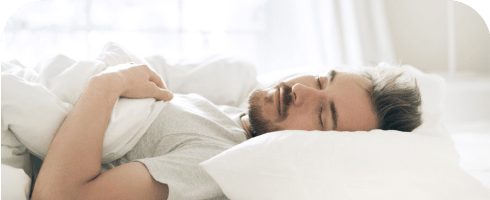
Back

Stomach
How to Choose a Knee Pillow
While you can certainly use a regular pillow between your legs, knee pillows are specially designed to offer more targeted support. These pillows come in a range of shapes, sizes, and firmness levels to better match your body type and sleep preferences. If you’re thinking of adding one to your sleep routine, here are some key features to keep in mind.
Contouring and Pressure Relief
Most knee pillows have a contoured or hourglass shape that fits naturally between the thighs and knees. This type of design helps keep your legs stable while promoting healthy spinal alignment. By cradling your legs in a fixed position, a well-shaped knee pillow can ease pressure on your hips, knees, and lower back.
Firmness
Knee pillows come in varying firmness levels, from soft and cushiony to firm and supportive. There’s no one-size-fits-all answer here — firmness is subjective and depends on what feels best for your body. Some people prefer a firmer pillow that maintains its shape throughout the night, while others like a softer option that molds more closely to the knees. If you’re unsure, look at reviews or consider trying a pillow with a generous return policy.
Size, Shape, and Weight
Knee pillows are generally smaller than regular bed pillows and come in ergonomic shapes like hourglass, wedge, or cylinder. Some also extend long enough to support the calves and ankles. Choosing the right size and shape depends on your body type and how much support you need. Larger individuals may prefer a wider pillow for more coverage, while smaller sleepers may feel more comfortable with a compact, lightweight option.
Keep in mind that a heavier pillow is less likely to shift during the night, but it shouldn’t be so large that it causes discomfort. If you’re trying to use a standard pillow instead, folding it in half can give it the loft needed to keep your knees separated.
Materials and Breathability
Look for high-quality materials that provide the right balance of comfort and support. Many knee pillows are made from memory foam, which offers excellent contouring but may retain heat. If you’re a hot sleeper, opt for a pillow with cooling gel or ventilated foam. Natural materials like latex or bamboo-derived fabrics also tend to sleep cooler.
The pillow cover matters, too. Since it’s in contact with your skin all night, breathability and comfort are key. Natural fiber covers, like cotton or bamboo, are great for airflow and moisture-wicking. If you have sensitive skin, a hypoallergenic or organic option may be best. Bonus: Many covers are removable and machine-washable, which makes cleaning easy.
Cost
Most knee pillows fall in the $20 to $60 range. Price is usually determined by the quality of materials, design, and brand. While it might be tempting to go for the cheapest option, spending a little more on a durable, well-constructed pillow can pay off in terms of comfort and longevity.

Still have questions? Ask our community!
Join our Sleep Care Community — a trusted hub of sleep health professionals, product specialists, and people just like you. Whether you need expert sleep advice for your insomnia or you’re searching for the perfect mattress, we’ve got you covered. Get personalized guidance from the experts who know sleep best.
References
2 Sources
-
Cary D, Briffa K, McKenna L. Identifying relationships between sleep posture and non-specific spinal symptoms in adults: A scoping review. BMJ Open. 2019;9(6):e027633. Published 2019 Jun 28. doi:10.1136/bmjopen-2018-027633
https://pmc.ncbi.nlm.nih.gov/articles/PMC6609073/ -
Lockwood, C. J., & Magriples, U. (2022, October 13). Prenatal care: Patient education, health promotion, and safety of commonly used drugs. In V. Berghella (Ed.) UpToDate.
https://www.uptodate.com/contents/prenatal-care-patient-education-health-promotion-and-safety-of-commonly-used-drugs

